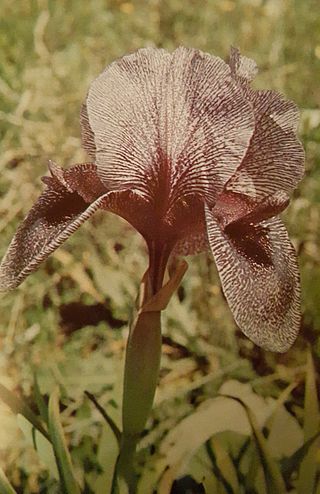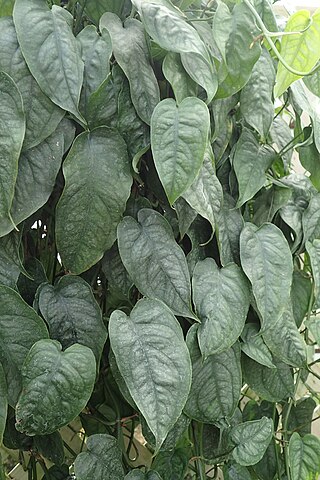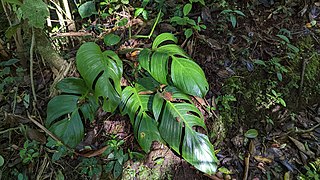
Chives, scientific name Allium schoenoprasum, is a species of flowering plant in the family Amaryllidaceae that produces edible leaves and flowers. Their close relatives include the common onions, garlic, shallot, leek, scallion, and Chinese onion.

Spearmint, also known as garden mint, common mint, lamb mint and mackerel mint, is a species of mint, Mentha spicata (, native to Europe and southern temperate Asia, extending from Ireland in the west to southern China in the east. It is naturalized in many other temperate parts of the world, including northern and southern Africa, North America, and South America. It is used as a flavouring in food and herbal teas. The aromatic oil, called oil of spearmint, is also used as a flavoring and sometimes as a scent.

Araucaria heterophylla is a species of conifer. As its vernacular name Norfolk Island pine implies, the tree is endemic to Norfolk Island, an external territory of Australia located in the Pacific Ocean between New Zealand and New Caledonia. It is not a true pine, which belong to the genus Pinus in the family Pinaceae, but instead is a member of the genus Araucaria, in the family Araucariaceae, which also contains the hoop pine. Members of Araucaria occur across the South Pacific, especially concentrated in New Caledonia where 13 closely related and similar-appearing species are found. It is sometimes called a star pine, Polynesian pine, triangle tree or living Christmas tree, due to its symmetrical shape as a sapling.

Magnolia grandiflora, commonly known as the southern magnolia or bull bay, is a tree of the family Magnoliaceae native to the Southeastern United States, from Virginia to central Florida, and west to East Texas. Reaching 27.5 m (90 ft) in height, it is a large, striking evergreen tree, with large, dark-green leaves up to 20 cm long and 12 cm wide, and large, white, fragrant flowers up to 30 cm (12 in) in diameter.

Monstera deliciosa, the Swiss cheese plant or split-leaf philodendron is a species of flowering plant native to tropical forests of southern Mexico, south to Panama. It has been introduced to many tropical areas, and has become a mildly invasive species in Hawaii, Seychelles, Ascension Island and the Society Islands. It is very widely grown in temperate zones as a houseplant.

Cassia fistula, also known as golden shower, purging cassia, Indian laburnum, Kani Konna, or pudding-pipe tree, is a flowering plant in the family Fabaceae. The species is native to the Indian subcontinent and adjacent regions of Southeast Asia. It is the official state flower of Kerala state in India. It is also a popular ornamental plant and is also used in herbal medicine.

Monstera is a genus of 59 species of flowering plants in the arum family, Araceae, native to tropical regions of the Americas.

Roscheria is an endangered, monotypic genus of flowering plant in the palm family. The genus is named for Albrecht Roscher, a 19th-century German explorer, and the epithet for its single species R. melanochaetes derives from Latin and Greek meaning 'black' and 'bristle', alluding to the spines covering the trunks. They naturally occur on the Mahé and Silhouette Islands of Seychelles where they grow in mountainous rainforest and are threatened by habitat loss.

Ligusticum scoticum, known as Scots lovage, or Scottish licorice-root, is a perennial flowering plant in the celery family Apiaceae found near the coasts of northern Europe and north-eastern North America. It grows up to 60 centimetres (24 in) tall and is found in rock crevices and cliff-top grassland. It is closely related to, and possibly conspecific with, Ligusticum hultenii from the coast of the northern Pacific Ocean. The plant is edible and contains the compound sotolon, which is also present in fenugreek. The leaves have a flavour similar to parsley or celery, while the seeds taste similar to fenugreek or cumin.

Monstera adansonii, the Adanson's monstera, Swiss cheese plant, or five holes plant, is a species of flowering plant from family Araceae which is widespread across much of South America and Central America. Besides South American countries it can also be found in the West Indies on islands such as Antigua, Grenada, Saba, St. Kitts, Guadeloupe, Marie Galante, Dominica, Martinique, St. Lucia, St. Vincent, Tobago, and Trinidad. The species is quite common near river valleys at lower elevations.

Monstera acuminata, or shingle plant, is a species of flowering plant from family Araceae which is widespread from Mexico to Central America. It is abundant in central Petén and extends north to San Luis Potosí, making it the northernmost of the species of Monstera.

Iris susiana, commonly known as the mourning iris, is a species of perennial plant in the family Iridaceae. The mourning iris is native to the Middle East. It grows in Lebanon, Syria and Turkey, although it is believed to be extinct in the wild. It is popular as a cut flower as the flowers can easily span 12 centimeters. The survival of the species is seriously threatened by excessive picking.

Monstera siltepecana is a species of flowering plant in the genus Monstera native to the wet tropical biomes of southern Mexico and Central America. Like other Monstera species, it is a vining plant and as it matures, develops holes in its leaves. Especially in immature foliage, it has distinctive silver venation. The monstera siltepecana is a very fast growing plant along with the other arum family members.
Monstera barrieri is a flowering plant of the genus Monstera and family Araceae.
Monstera cenepensis is a species of flowering plants in the family Araceae.
Monstera juliusii is a flowering plant in the arum family (Araceae). It is native to high-altitude cloud forests of Costa Rica at altitudes of 1,600 to 2,250 metres and occasionally confused with Monstera standleyana. However, M. standleyana has green petioles, few fenestrations and thin leaves, while M. juliusii is characterized by mottled white petioles, frequent fenestrations at maturity and thick, leathery leaves. Mature plants have pinnatilobed leaves as long as 60 cm and 30 cm wide, with circular fenestrations close to the margins, and oval fenestrations near the midrib. The species is named after Julius Johnson, son of the artists Rashid Johnson and Sheree Hovsepian.
Monstera membranacea is a species of flowering plant in the genus Monstera of the arum family, Araceae.

Monstera monteverdensis is a species of flowering plant in the arum family, Araceae. Its adult form is characterized by pinnatifid margins with up to eight lobes per side, with occasional fenestrations away from the midrib. Leaves can grow as large as 60 cm long and 30 cm wide. It is named after the city of Monteverde, where the species is abundant.

Monstera tuberculata is a species of plant in the genus Monstera native from Mexico south to Panama. It grows in lowland wet tropical biomes up to 200 metres (660 ft) in elevation. Similar to Monstera dubia and a few other species in its genus, when young M. tuberculata has a shingle-like growth habit with leaves tightly pressed against the trunks of trees. As it matures, it has short-stemmed, oval leaves that lack the fenestrations of better-known species like Monstera deliciosa. Unusually for an aroid, its fruit hangs like a pendant.

Rhaphidophora pertusa is a climbing species of aroid plant within the genus Rhaphidophora of the Araceae family. The species—which, superficially, is quite similar to R. tetrasperma—is found on the Andaman-Nicobar Islands and the Maldives, as well as in Bangladesh, India, Myanmar, Thailand and Sri Lanka.















